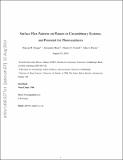Files in this item
Surface flux patterns on planets in circumbinary systems and potential for photosynthesis
Item metadata
| dc.contributor.author | Forgan, Duncan H. | |
| dc.contributor.author | Mead, Alexander | |
| dc.contributor.author | Cockell, Charles S. | |
| dc.contributor.author | Raven, John A. | |
| dc.date.accessioned | 2018-01-25T15:30:07Z | |
| dc.date.available | 2018-01-25T15:30:07Z | |
| dc.date.issued | 2015-07-01 | |
| dc.identifier | 252129685 | |
| dc.identifier | 0b680d29-fc95-46d7-838b-f00624c9f3f6 | |
| dc.identifier | 84929842852 | |
| dc.identifier.citation | Forgan , D H , Mead , A , Cockell , C S & Raven , J A 2015 , ' Surface flux patterns on planets in circumbinary systems and potential for photosynthesis ' , International Journal of Astrobiology , vol. 14 , no. 3 , pp. 465-478 . https://doi.org/10.1017/S147355041400041X | en |
| dc.identifier.issn | 1473-5504 | |
| dc.identifier.other | BibCode: 2015IJAsB..14..465F | |
| dc.identifier.uri | https://hdl.handle.net/10023/12612 | |
| dc.description.abstract | Recently, the Kepler Space Telescope has detected several planets inorbit around a close binary star system. These so-called circumbinary planets will experience non-trivial spatial and temporal distributions of radiative flux on their surfaces, with features not seen in their single-star orbiting counterparts. Earth-like circumbinary planets inhabited by photosynthetic organisms will be forced to adapt to these unusual flux patterns. We map the flux received by putative Earth-like planets (as a function of surface latitude/longitude and time) orbiting the binary star systems Kepler-16 and Kepler-47, two star systems which already boast circumbinary exoplanet detections. The longitudinal and latitudinal distribution of flux is sensitive to the centre-of-mass motion of the binary, and the relative orbital phases of the binary and planet. Total eclipses of the secondary by the primary, as well as partial eclipses of the primary by the secondary add an extra forcing term to the system. We also find that the patterns of darkness on the surface are equally unique. Beyond the planet's polar circles, the surface spends a significantly longer time in darkness than latitudes around the equator, due to the stars' motions delaying the first sunrise of spring (or hastening the last sunset of autumn). In the case of Kepler-47, we also find a weak longitudinal dependence for darkness, but this effect tends to average out if considered over many orbits. In the light of these flux and darkness patterns, we consider and discuss the prospects and challenges for photosynthetic organisms, using terrestrial analogues as a guide. | |
| dc.format.extent | 2205759 | |
| dc.language.iso | eng | |
| dc.relation.ispartof | International Journal of Astrobiology | en |
| dc.rights | © 2014, Cambridge University Press. This work has been made available online in accordance with the publisher’s policies. This is the author created, accepted version manuscript following peer review and may differ slightly from the final published version. The final published version of this work is available at https://doi.org/10.1017/S147355041400041X | en |
| dc.subject | Circumbinary | en |
| dc.subject | Darkness | en |
| dc.subject | Habitability | en |
| dc.subject | Photosynthesis | en |
| dc.subject | QB Astronomy | en |
| dc.subject | QC Physics | en |
| dc.subject | NDAS | en |
| dc.subject.lcc | QB | en |
| dc.subject.lcc | QC | en |
| dc.title | Surface flux patterns on planets in circumbinary systems and potential for photosynthesis | en |
| dc.type | Journal article | en |
| dc.contributor.institution | University of St Andrews.School of Physics and Astronomy | en |
| dc.identifier.doi | 10.1017/S147355041400041X | |
| dc.description.status | Peer reviewed | en |
| dc.identifier.url | http://adsabs.harvard.edu/abs/2015IJAsB..14..465F | en |
This item appears in the following Collection(s)
Items in the St Andrews Research Repository are protected by copyright, with all rights reserved, unless otherwise indicated.

